Date: 05/01/2023
Relevance: GS-2: India and its neighborhood- relations, Bilateral, regional and global groupings and agreements involving India and/or affecting India’s interests.
Relevance: GS-3: Security challenges and their management in border areas
Key Phrases: India-China LAC standoff, Galwan Skirmishes, People’s Liberation Army (PLA), India-China border issues, Pangong Tso, Yangtse, Multi-Domain Operations (MDOs), Boosting Infrastructure.
Context:
- Recently, the External Affairs Minister of India remarked that the persistent incursions and tensions at the LAC are a real threat and requires deployment of Indian armed forces in an unprecedented way.
- The Indian armed forces have the capability to face the Chinese but at the same time we must augment our infrastructure in technical advancements such as the multi-domain operations (MDO).
The Eastern Sector of the LAC and Tawang issue
- In the eastern sector of the LAC India shares a 1140 km boundary with China.
- The boundary line is called McMahon Line which runs from the eastern limit of Bhutan to a point near the Talu Pass at the trijunction of Tibet, India, and Myanmar.
- The majority of the territory of Arunachal Pradesh is claimed by China as a part of Southern Tibet.
- China considers the McMahon line illegal which was proposed under the Simla Accord in 1914 to settle the boundary between Tibet and India, and Tibet and China.
- Though the Chinese representatives at the meeting initialed the agreement, they subsequently refused to accept it.
- Tawang Sector issue
- According to the Simla Accord, Tibet relinquished some of its territories, including Tawang, to the British but it was not recognised by China.
- In 1950, Tibet lost its de facto independence and was incorporated into the newly established People's Republic of China.
- During the Sino-Indian war of 1962, Tawang fell briefly under Chinese control, but China voluntarily withdrew its troops at the end of the war.
- Tawang again came under Indian administration, but China has not relinquished its claims on most of Arunachal Pradesh including Tawang.

Understanding Multi-Domain Operations (MDOs)
- The term MDO comprises operations conducted across multiple domains and contested spaces through convergence of capabilities to overcome an adversary’s strengths by presenting it with operational and/or tactical predicaments.
- This means having a common operating system which covers all the domains and decides which tool is the best tool for a given task.
- Hence, it is not one service using capabilities in multiple domains to do a task but the best positioned and capable operator of any service doing it across any domain.
- It is more than just actions on land, in sea, air, cyber, space and in
the electromagnetic spectrum.
- For e.g. an Army coastal missile battery could be tasked to strike an enemy naval vessel detected by the radar of an Air Force aircraft.
- Or an Air Force’s armed unmanned aerial vehicle on an Intelligence, Surveillance and Reconnaissance mission could be diverted to use its weapons against an Army target detected by a naval/civilian satellite.
How does the MDO architecture work?
- To understand the working, let's take a task wherein the MDO architecture uses any sensor and the best positioned shooter to accomplish objectives.
- The technical complexity and the command, control and communication (C3) structure required can be understood
- MDO and its C3 structure would have inputs from all sensors to come up with an optimum engagement solution using artificial intelligence.
- It occurs through three operations-
- First, all sensors (and other information input sources) must be capable of being hosted on the MDO architecture.
- Second, all solution providers (executors) must be able to receive inputs and instructions from the MDO C3 structure and carry them out.
- Third, if the link to the main structure is not available (say, jammed by the enemy), the mission command characteristics of distributed control would come into play so that operations continue.

Prerequisites to MDO implementation
- Expensive and highly advanced scientific technologies
- The MDO architecture can only be built using pioneering advanced scientific technologies and requires highly developed scientific infrastructure along with huge amounts to finance it.
- Need of a planned and clear execution strategy
- It would require a clear-cut roadmap regarding the planning, acquisition, staffing and training.
- Tech outsourcing and reliability
- Most of the MDO architecture is built using advanced techs which are available in the USA and India will need to not only outsource such techs but also pour in money and resources into an American concept.
What is the need of MDO implementation in India?
- China threat
- Although the US is making huge progress into the MDO as it has been pushing aggressively for the MDO in the past decade.
- China is attempting to match U.S. military power and is not lagging far which is a real threat to India.
- Reliability of MDOs use and recent success
- The reliability of MDOs is evident in the current Russia-Ukraine conflict where Western specialists are helping Ukrainians utilise the power of algorithms to fuse reconnaissance from space and choose the best shooters to strike Russian targets.
- As an article in The Washington Post has written that “Ukrainians are fusing their courageous fighting spirit with the most advanced intelligence and battle-management software ever seen in combat.”
- Regional Peace
- The MDOs are highly desirable to maintain the regional peace because if left behind, India would be deterred by denial during peacetime because if China, which has the technology and finances, masters it will pose a danger to peace and tranquility in the region in a big way.
- Therefore, India has no choice but to embrace MDOs at the earliest.
A Four-pronged strategy to implement MDOs is the way forward
- First, in the short-term, traditional physical domains must be stabilized, with critical deficiencies of the services being plugged.
- Second, our C3 networks need to be hardened and protected against
cyber threats.
- They need to be linked and synchronized so that seamless exchange of data is ensured.
- Third, for the long term, a pilot project must be started now so
that the true challenge of creating an MDO environment is grasped.
- The pilot project would identify the technologies required and, equally importantly, an idea of the monies necessary.
- Fourth, to get the fundamentals of MDO right, it is vital to train and educate personnel starting now on the lines of the US Air Force which has training courses for such domains.
- In these changed times scientific advancements should be taken into consideration to strengthen the ones who are at battlefields.
Conclusion
- The future of warfare will be high-paced, multi-dimensional, and connected therefore to prepare for large scale combat operations in a high paced war scenario the MDO could be the way out.
- As the threats and near-peer rivals continue to evolve, but the ability of the Indian Armed forces to adapt to changing conditions coupled with advanced techno warfare can deter the enemy which will not only help secure our borders but also the sovereignty and integrity of the nation.
Source: The Hindu
Mains Question:
Q. What do you understand by Multi-Domain Operations (MDOs)? Do you think India should invest its resources to establish MDOs infrastructure to prepare for large scale combat operations in the future warfare? (250 words)






















